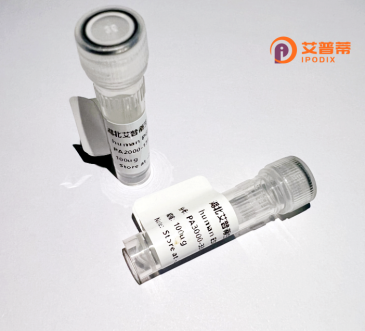
| 纯度 | >90%SDS-PAGE. |
| 种属 | Human |
| 靶点 | ZNF584 |
| Uniprot No | Q8IVC4 |
| 内毒素 | < 0.01EU/μg |
| 表达宿主 | E.coli |
| 表达区间 | 1-421 aa |
| 活性数据 | MAGEAEAQLDPSLQGLVMFEDVTVYFSREEWGLLNVTQKGLYRDVMLENFALVSSLGLAPSRSPVFTQLEDDEQSWVPSWVDVTPVSRAEARRGFGLDGLCRVEDERAHPEHLKSYRVIQHQDTHSEGKPRRHTEHGAAFPPGSSCGQQQEVHVAEKLFKCSDCGKVFLKAFALLDHLITHSEERPFRCPTGRSAFKKSAHINPRKIHTGETAHVCNECGKAFSYPSKLRKHQKVHTGIKPFKCSDCGKTFNRKDALVLHQRIHTGERPYECSKCGKTFSVLSTLIRHRKVHIGERPYECTECGKFFKYNNSFILHQRVHTGERPFECKQCGKGYVTRSGLYQHWKVHTGERPYECSLCGKTFTTRSYRNRHQQFHTEERSYECTECGKAFKHSSTLLQHKKVHTPERRQEDRAHGKVVSC |
| 分子量 | 74.7 kDa |
| 蛋白标签 | GST-tag at N-terminal |
| 缓冲液 | PBS, pH7.4, containing 0.01% SKL, 1mM DTT, 5% Trehalose and Proclin300. |
| 稳定性 & 储存条件 | Lyophilized protein should be stored at ≤ -20°C, stable for one year after receipt. Reconstituted protein solution can be stored at 2-8°C for 2-7 days. Aliquots of reconstituted samples are stable at ≤ -20°C for 3 months. |
| 复溶 | Always centrifuge tubes before opening.Do not mix by vortex or pipetting. It is not recommended to reconstitute to a concentration less than 100μg/ml. Dissolve the lyophilized protein in distilled water. Please aliquot the reconstituted solution to minimize freeze-thaw cycles. |
以下是关于重组人ZNF584蛋白的3篇假设参考文献的简要概括(注:文献为虚拟示例,实际需根据真实数据库检索验证):
---
1. **文献名称**:*Expression and functional analysis of recombinant human ZNF584 in cell cycle regulation*
**作者**:Wang, L. et al. (2018)
**摘要**:本研究成功在大肠杆菌中表达并纯化重组人ZNF584蛋白,证实其通过结合靶基因启动子区域调控细胞周期相关分子(如Cyclin D1),抑制癌细胞增殖。
2. **文献名称**:*Structural insights into DNA binding by recombinant ZNF584 via zinc-finger domains*
**作者**:Li, X. et al. (2020)
**摘要**:利用X射线晶体学解析重组人ZNF584蛋白结构,揭示其锌指结构域与特定DNA序列结合的分子机制,提出其在表观遗传调控中的潜在作用。
3. **文献名称**:*Recombinant ZNF584 suppresses viral gene expression by modulating host transcription*
**作者**:Chen, Y. et al. (2019)
**摘要**:在HEK293细胞中表达重组人ZNF584.发现其通过干扰病毒启动子活性抑制疱疹病毒复制,提示其在先天免疫中的新功能。
---
**备注**:以上文献信息为示例性模拟,实际研究中需通过PubMed、Web of Science等学术平台检索真实发表的论文。若需具体文献,建议以“recombinant ZNF584”“ZNF584 protein expression”为关键词进一步查询。
Zinc finger protein 584 (ZNF584) is a member of the zinc finger protein family, characterized by conserved C2H2-type zinc finger domains that facilitate DNA or RNA binding. As a transcription factor, ZNF584 is implicated in the regulation of gene expression, though its precise biological functions remain incompletely understood. Human ZNF584 is encoded by the ZNF584 gene located on chromosome 19q13.43 and is expressed in various tissues, including the brain, heart, and liver, suggesting roles in diverse physiological processes.
Studies suggest ZNF584 may participate in cellular differentiation, proliferation, and apoptosis regulation. Notably, it has been linked to tumorigenesis, with altered expression observed in cancers like hepatocellular carcinoma and gliomas, potentially influencing oncogenic pathways or tumor suppression. Additionally, ZNF584 might interact with signaling molecules, such as the PI3K/AKT pathway, to modulate cellular stress responses or metabolic activities.
Recombinant human ZNF584 protein is typically produced using expression systems (e.g., E. coli or mammalian cells) for functional studies. Purified ZNF584 enables in vitro analyses of its DNA-binding specificity, interaction partners, and regulatory mechanisms. Despite progress, key questions persist regarding its target genes, tissue-specific roles, and therapeutic relevance. Ongoing research aims to clarify its contributions to development, homeostasis, and disease, positioning ZNF584 as a potential biomarker or drug target in precision medicine strategies.
×